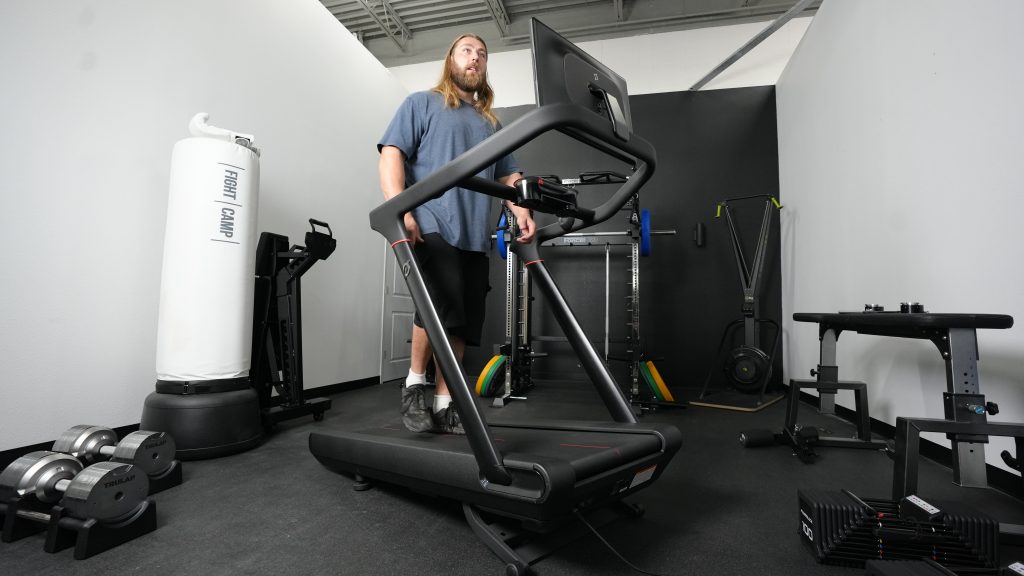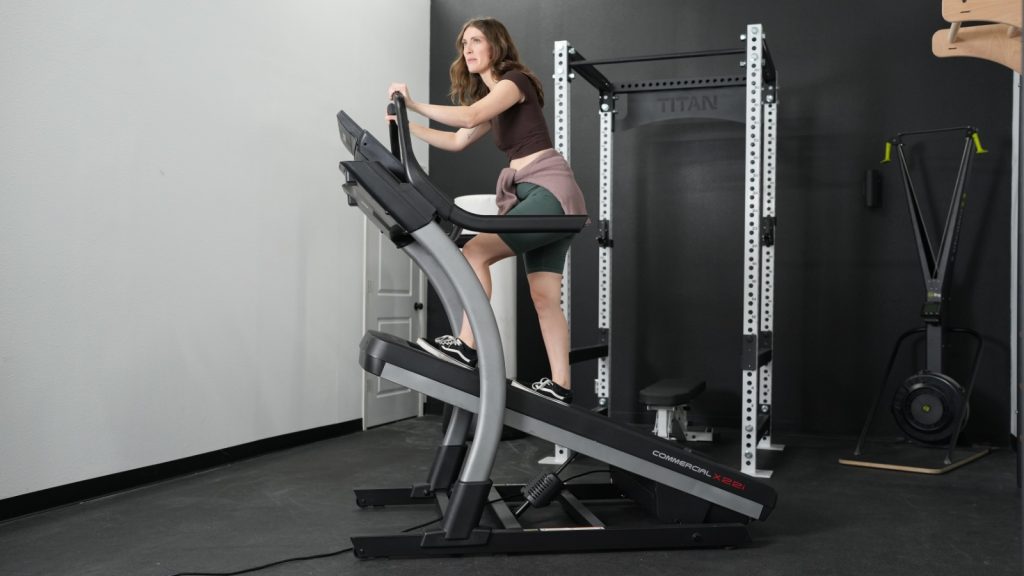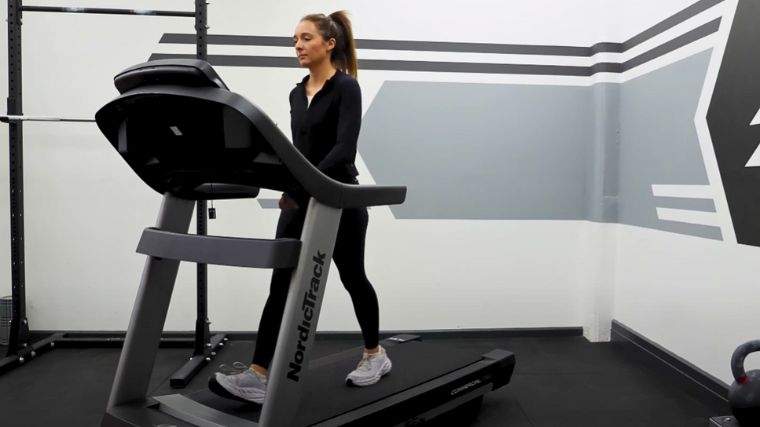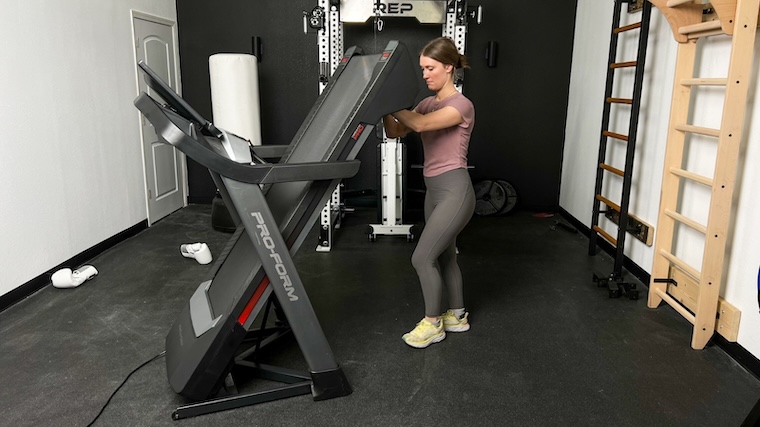You’ve heard the rumors (shhh, don’t tell anybody that I told you, but they’re true) about the benefits of cardio — lifted moods, managed weight, and strengthened hearts, to name a few — and you’re looking to get in on the action. (1)(2) Whether you’re perusing the best treadmills to support some serious mileage or considering a budget-friendly model for occasional use, size matters.
Understanding the various moving parts of a treadmill and the different sizes available is key when picking the right machine to suit your height, available space, and training. This treadmill size guide will walk you through the most important considerations, from a machine’s footprint and height clearance to its running belt dimensions and additional features.
Common Treadmill Dimensions
“You might think, ‘A treadmill is a treadmill,’ but this couldn’t be further from the truth,” says our expert reviewer, Amanda Capritto. “Well, of course, all treadmills ARE treadmills, but there are many different types of treadmills and factors to consider.” Let’s see what the general sizing is for these conveyor belts to nowhere.
Length, Width, and Height
While home treadmills come in a wide variety of footprints, you’ll tend to find the average machine is between 60 and 84 inches long and 24 to 36 inches wide. Less universal is the height of a treadmill. The best under-desk treadmills tend to be between 5 and 7 inches tall, making them ideal for use during the workday. Standard treadmills, meanwhile, tend to stand roughly 48 to 60 inches tall.
Belt Size
“A comfortable running deck for walking is 16 to 20 inches wide by 50 to 55 inches long. For running, and especially sprinting, you’ll want a deck of 20 inches wide by 60 inches long,” says Capritto.

Commercial treadmills tend to feature 60-inch running decks, while budget machines can be a bit shorter, often measuring between 50 and 55 inches. Walking or under-desk treadmills can range from 34 inches up to around 50 inches.
While it’s easy to think more is better, not every athlete needs a 60-inch treadmill deck, especially if they’re just interested in brisk walks or jogs. In fact, I’m 5 feet 5 inches and I comfortably walk at a pace up to 4 miles per hour on the EgoFit Pro under-desk treadmill, which features a 34-inch belt. This is due to the smaller stride taken when a user is moving at a slower pace.
Belt widths, on the other hand, can range between 13 and 22 inches. As with length, smaller models are typically designed for walking, not running.
Regardless, anybody interested in buying a treadmill will want to hit up their local gym or fitness retailer to see which deck length best accommodates their stride. The last thing you want during a sprint is for your feet to slip off the belt, as that could result in serious injury.
Foldable Treadmills
If space in your home gym or apartment is limited, a folding treadmill might be up your alley. These machines have decks that fold up vertically, potentially halving the machine’s overall footprint when not in use. Others can have handrails that fold flat to make storage under beds or in closets a possibility.

As such, the dimensions of the best folding treadmills when folded can range from 5 inches to 70 inches tall, 24 to 44 inches long, and 24 to 36 inches wide. When folded, the width of these treadmills tends to stay the same, while the height and length change.
Space Requirements
While you may think you’ve found the perfect fitness equipment for you and your fitness goals, you’ll need to make sure your new treadmill fits in the space you have available. While perusing footprints can give you a general idea of what machine will work in your home, keep in mind that you’ll also want to leave room on the sides and back of the machine for easy step-up (and also safety reasons).
Measure Your Space
“Check the overall length, width, and height of the machine in its assembled position and folded position if applicable. And triple-measure your space to make sure it will fit,” notes Amanda Capritto, certified personal trainer and our expert reviewer.
Clearance
It’s also a good idea to account for extra room around your treadmill to allow for full functionality and safety. Consider giving yourself about 2 feet on either side of the treadmill and 6 feet behind the treadmill.

While this provides you with enough room to comfortably step up onto your machine, it’s also a safety precaution to keep you from slamming into a wall or piece of furniture that could injure you should you slip, fall, or hit the belt.
The Right Treadmill Size for You
Whether you’re perusing the best compact treadmills or are curious about more high-end offerings, you’ll want a machine that fits you space, fits your frame, and allows you to tackle the workout programs you’re keen on.
Stride Length and User Height
“You’ll want a running deck at least 60 inches in length to accommodate the length of a typical running stride,” says BarBend expert reviewer Amanda Capritto. “Shorter individuals may be able to get away with a shorter deck; taller individuals may need to look for a deck even longer than 60 inches, although this can be tough to find and will cost you more money.”
She continues, “As for width, 20 to 22 inches is ideal in order to accommodate arm motion while running and potential side-to-side movement that can occur when sprinting.”

To make sure the treadmill’s running deck can fit your height and stride length, you have a couple of options.
- Hit up a local gym or fitness store to see which deck length and width makes you most comfortable while walking, jogging, and running.
- If that option isn’t a possibility, you can calculate your stride length, which is the distance from one foot fall to the next, measured from heel to heel. To calculate this, take the distance you’ve run and divide that by your total number of steps.
- Women can take their height in inches and multiply this by 0.413 to find an approximate stride length. (3)
- Men can take their height in inches and multiply this by 0.415 to find an approximate stride length. (3)
- Or skip all of this and read our list of the best treadmills for tall runners, which features some of the most comfortable and spacious decks we’ve tried and tested.
Treadmill Motors
Unlike manual models, electric treadmills utilize motors with horsepower (HP) and continuous horsepower (CHP). Horsepower represents a motor’s capacity at peak operation, while continuous horsepower indicates how much intensity the motor can put out at a continuous pace. Basically, CHP signals a more powerful motor when compared to HP motors, which aren’t as strong and have a shorter lifespan.

Capritto recommends the following, “Ideal treadmill specs [are a] motor with CHP of 1.75 to 2.5 for walking and 2.5 or higher for jogging. 3.0 to 4.0 CHP is ideal for running and sprinting at top speeds.”
To determine what CHP fits your need for speed and how often you (and the rest of your household) will use it, peruse the list below to help you find the right treadmill motor for you.
| Type of Training | Maximum Speed | Low Use (1-3 times per week) | High Use (4+ times per week) |
| Walking | 0.5-4 MPH | 1.5 CHP | 2.0 CHP |
| Jogging | 4.1-6 MPH | 2.0 CHP | 2.5 CHP |
| Running | 6.1+ MPH | 2.5 CHP | 3.0+ CHP |
Type of Training
Regardless of your fitness level, decide what type of treadmill workouts you’re looking to accomplish. If you’re a casual jogger on a weight loss journey or are training for an ultramarathon, knowing this will help guide you towards the right belt deck length and the appropriate motor power for your sweat sesh.
Treadmill Features That Impact Size
Similar to other cardio equipment, like exercise bikes and ellipticals, larger treadmills with hefty footprints often come with more features to support your health and fitness goals. Knowing what features take up more space can help you identify equipment that may be exactly what you’re looking for or something that may take up too much room.
Incline
“If you plan to use your treadmill to train for outdoor events such as a marathon or a hike, incline is essential. Budget-friendly models typically have incline ranges of 3 to 9 percent, while more cash can get you from 9 to 15 percent,” says Amanda Capritto, our expert reviewer. Incline treadmills, however, tend to weigh more and take up more space than treadmills without this capability.
Additionally, incline treadmills may also impact your overhead clearance while on the treadmill, so users who plan to place their equipment in rooms with low ceilings will want to calculate whether or not they’ll have enough headroom when climbing. (FYI: Per the National Building Code, the standard ceiling height is 8 feet tall, so we qualify a low ceiling as anything under 8 feet.) (4)
The average step-up height of a treadmill is between 8 and 10 inches, and you’ll also want to factor in the height of the belt at its max incline. Combine those measurements with your own height and that should provide you with the amount of clearance between your head and the ceiling. Ideally, you’ll want roughly a foot of overhead clearance since you’ll likely be bouncing slightly during runs.
Tech and Touchscreens
You’ll often find touchscreens, app connectivity, and Bluetooth compatibility on models with heavier builds and larger dimensions. Unlike basic LCD displays, touchscreens are generally around 10 inches to 20 inches large, and maneuvering these treadmills around when there’s basically a TV screen attached to one side can be a struggle.

For example, the NordicTrack X32i treadmill features an iFIT-enabled 32-inch touchscreen display, plus a 40-percent incline and a 65-inch deck with cushioning and shock absorption. Those are great features, but they result in a treadmill that weighs a whopping 462 pounds, roughly 150 to 200 pounds more than the average treadmill. In terms of dimensions, it measures 76.5 inches tall, 73 inches long, and 40 inches wide — a little shy of the size of a three-seater sofa. (5)
“Because treadmills with screens are often larger models, be sure to check the overall dimensions of the machine and measure — and measure again! — the space in which you intend to place it,” notes Capritto. “You may want to look for treadmills that fold if you need the floor space when the machine is not in use.”
Manual Treadmills
Outside of Bluetooth functionality and the occasional heart rate monitor, manual treadmills tend to lack the tech features seen on many motorized treadmills. This limitation — plus their lack of motors — can sometimes make for a more compact and manageable piece of equipment. However, due to their steel frames and heavy treads, they can often weigh more than motorized treadmills.
Final Word
“Finding a treadmill that’s just right for your needs — your Goldilocks — will require some research and knowledge of treadmill specifications,” says BarBend expert reviewer and certified personal trainer Amanda Capritto. Now that you’re armed with some insight into treadmill sizing, you’ll be better prepared to find a treadmill that fits your home, your fitness goals, and you!
Your first step before investing in exercise equipment is figuring out what space you have available to house your new toy. Once you’ve figured out what you’re working with, use this treadmill size guide to help you find the best treadmill for walking, running, or sprinting your little heart out.
Treadmill Size Guide FAQs
How long should my treadmill be?
We like to recommend belt decks of 60 inches for runners, 55 inches for joggers, and anything over 48 inches for walkers. However, the right deck length is totally dependent on your stride length. Shorter athletes can get away with shorter belt decks, while taller runners may need a belt deck more than 60 inches. I’m 5 feet 5 inches and my walking treadmill has a deck length of 34.5 inches, which suits me just fine when I’m logging steps during the day.
What is the standard home treadmill size?
A standard motorized treadmill measures about 60 to 72 inches tall, 60 to 84 inches long, and 24 to 36 inches wide.
How close should a treadmill be to a wall?
You’ll want to have 6 feet of clearance behind your treadmill and 2 feet of clearance on each side. This spacing makes it easy to hop on or off your equipment and ensures you won’t crash into a wall or nearby furniture if you slip and fall during a run.
References
- Markotić, V., Pokrajčić, V., Babić, M., Radančević, D., Grle, M., Miljko, M., Kosović, V., Jurić, I., & Karlović Vidaković, M. (2020). The Positive Effects of Running on Mental Health. Psychiatria Danubina, 32(Suppl 2), 233–235.
- Kutac, P., Bunc, V., Buzga, M., Krajcigr, M., & Sigmund, M. (2023). The effect of regular running on body weight and fat tissue of individuals aged 18 to 65. Journal of physiological anthropology, 42(1), 28. https://doi.org/10.1186/s40101-023-00348-x
- Bumgardner, W. (2024, May 13). How to calculate stride length by height. Verywell Fit. https://www.verywellfit.com/set-pedometer-better-accuracy-3432895
- Rybczynski, W. (n.d.). Ceiling Heights in Homes and Offices. Ceiling Heights in homes and offices – Zell/Lurie Real Estate Center. https://realestate.wharton.upenn.edu/working-papers/ceiling-heights-in-homes-and-offices/
- Jaramillo, C. (2022, December 29). A guide to sofa dimensions & sizes. SeatUp, LLC. https://seatup.com/blogE/guide-to-sofa-dimensions/